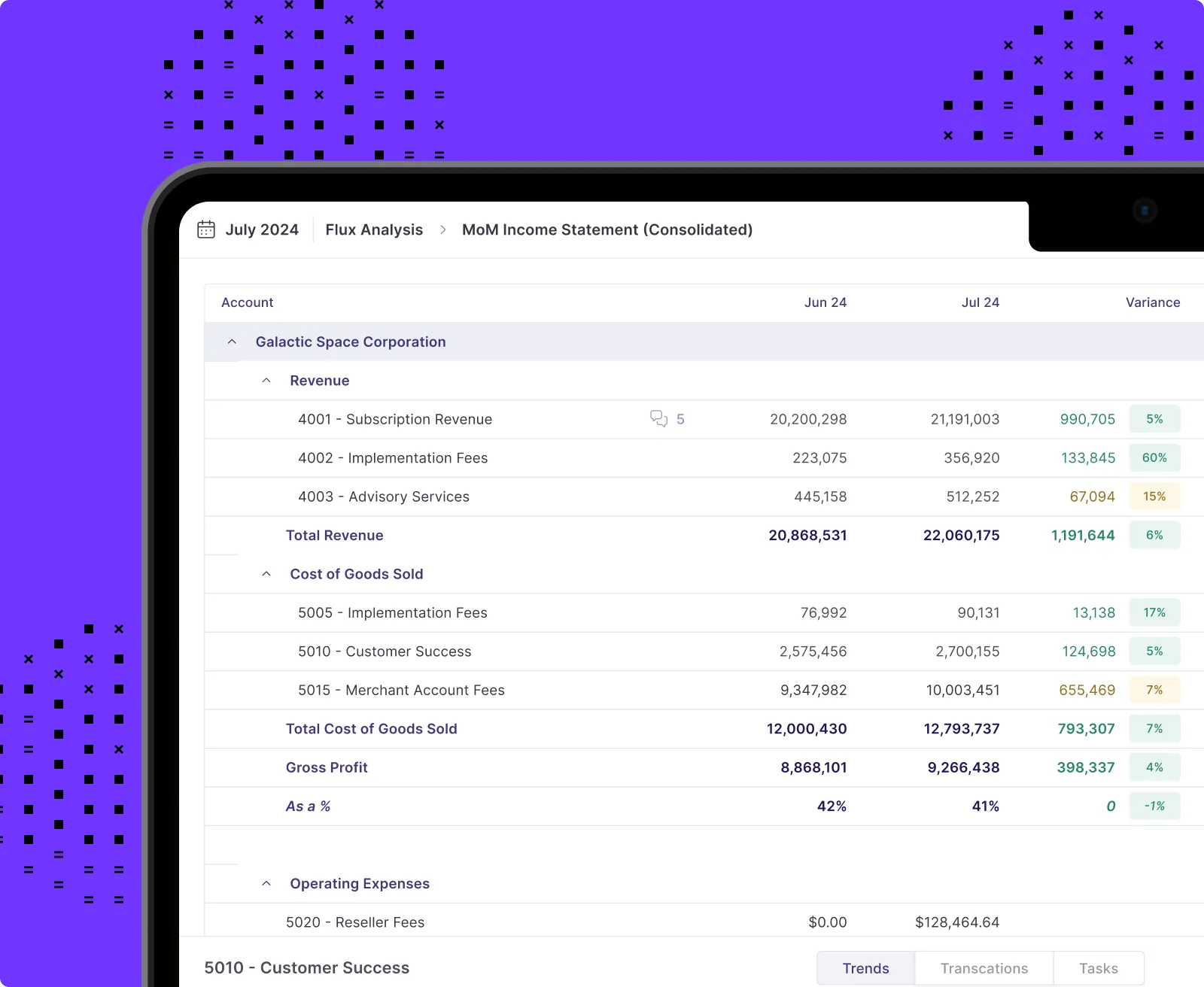Fixed Asset Depreciation Decoded: What Method to Use?
.webp)
For accounting teams managing high volumes of fixed assets, depreciation is a cornerstone of accurate financial reporting and tax efficiency. Whether it's a fleet of vehicles, a server farm, or manufacturing machinery, fixed asset depreciation ensures costs are spread over time, aligning with asset usage and operational reality. Controllers overseeing complex portfolios know that even minor miscalculations can disrupt financial statements and create compliance risks.
This guide will walk you through the essentials of fixed asset depreciation as well as its financial impact across all three statements. With fixed assets representing a significant share of the balance sheet and serving as a cornerstone of CIP accounting, mastering depreciation is key to building accurate, audit-ready reports and supporting strategic decision-making.
Understanding Fixed Asset Depreciation
Fixed asset depreciation accounts for the gradual decline in value of tangible assets caused by wear and tear, obsolescence, or usage. It ensures that the cost of items like equipment, buildings, or machinery is spread systematically over the years they contribute to the business.
In accounting, the purpose of depreciation is to match expenses with revenue. For example, when a company buys manufacturing equipment, the related depreciation expense is matched with the revenue that equipment generates. This approach aligns with the matching principle, a core concept in accounting.
Depreciation significantly impacts all three financial statements:
- Income Statement: Depreciation is recorded as an expense, reducing net income and directly influencing profit margins
- Balance Sheet: Accumulated depreciation decreases the book value of fixed assets over the asset lifecycle
- Cash Flow Statement: As a non-cash expense, depreciation is added back to net income in the operating activities section
Why Fixed Asset Depreciation Matters
Enhancing Financial Accuracy
Depreciation ensures financial statements reflect an asset's real value by accounting for wear and obsolescence. Without it, businesses risk overstating assets and their functionality and misrepresenting profitability. The matching principle ensures expenses align with revenue generated by assets over time.
Adam Heeger, former revenue accountant at Meta and Numeric's Solutions Lead, sees fixed asset depreciation as a necessary and impactful process for businesses:
.webp)
Maximizing Tax Efficiency
Depreciation lowers taxable income, freeing up cash for reinvestment. U.S. tax codes offer multiple methods to accelerate tax deductions, including:
- MACRS (Modified Accelerated Cost Recovery System): Allows businesses to depreciate assets faster for tax benefits
- Section 179: Permits full deduction of asset costs in the purchase year, up to IRS limits
- Bonus Depreciation: Enables immediate deductions for eligible assets, often complementing Section 179
Supporting Capital Planning
Depreciation schedules forecast asset replacement needs, helping businesses plan for capital expenditures. Controllers use depreciation data to identify underperforming assets, determine optimal replacement timing, and optimize budgets for future investments.
Common Types of Depreciable Fixed Assets
Depreciable fixed assets include various tangible resources used in operations, all of which lose value over time due to wear, obsolescence, or regular use:
- Buildings: Commercial structures, warehouses, and manufacturing facilities
- Vehicles: Company cars, delivery trucks, and specialized transportation equipment
- Machinery & Equipment: Production equipment, assembly lines, and operational tools
- Technology Assets: Computers, servers, networking equipment, and hardware systems
Determining Useful Life and Salvage Value
Figuring out an asset's useful life requires careful judgment and consideration of multiple factors:
- Expected usage patterns: Assets in high-volume production wear out faster than those used occasionally
- Operational capacity: Assets running near maximum capacity typically have shorter useful lives
- Technological advancements: Equipment susceptible to obsolescence (like IT hardware) often needs shorter depreciation periods
- Legal or contractual limits: Lease terms or regulatory requirements may define how long an asset is considered useful
- Maintenance habits: Consistent upkeep can extend asset life, while neglecting maintenance shortens it
Salvage value—the expected remaining worth of an asset at the end of its life minus disposal costs—also requires judgment. Market conditions, asset type, and industry standards all influence this estimation. For intangible assets, salvage value is generally assumed to be zero unless evidence suggests otherwise.
Accurate estimation of both useful life and salvage value is critical for reliable financial statements. Errors can lead to over- or under-depreciation, potentially distorting profit margins and asset valuations.
Exploring Types of Depreciation
Choosing the right depreciation method is crucial for accurate financial reporting and aligning expenses with how assets are used. Each method serves a specific purpose:
Straight-Line Depreciation
The simplest and most widely used method, the straight-line method of depreciation divides the cost of an asset evenly across its useful life.
Formula: (Cost - Salvage Value) / Useful Life
Best for: Assets that lose value at a steady rate over time, like office equipment or buildings
Declining Balance Method
Declining balance depreciation is an accelerated depreciation method that recognizes higher expenses in an asset's early years when it is often most productive or valuable.
Formula: Book Value at Beginning of Year × Depreciation Rate
Best for: Assets that lose value quickly after purchase, such as technology equipment or vehicles
Units of Production Method
Units of production depreciation expenses on actual usage or output, offering a precise approach for specific assets.
Formula: (Cost - Salvage Value) / Total Estimated Units × Units Produced
Best for: Machinery or equipment where wear and tear is directly tied to usage
Sum-of-the-Years' Digits (SYD) Method
This accelerated method assigns higher depreciation expenses in the early years and gradually lowers them across later years.
Formula: (Cost - Salvage Value) × (Remaining Life / Sum of the Years' Digits)
Best for: Assets with higher productivity or value early in their life, such as specialized machinery or vehicles
Modified Accelerated Cost Recovery System (MACRS)
The standard method used for tax purposes in the United States, MACRS allows businesses to depreciate assets quickly over predefined recovery periods set by the IRS.
Best for: Reducing taxable income while following IRS regulations
Maintaining a Depreciation Schedule with Numeric's Fixed Asset Workpaper Template
Tired of wrestling with fixed asset tracking and depreciation calculations? Numeric's Fixed Asset Workpaper Template makes life easier for accounting teams juggling multiple assets, entities, and depreciation schedules.
The template helps you:
- Track asset additions, transfers, and disposals in one organized place
- Test if your depreciation amounts looks reasonable (and catch errors before auditors do)
- Easily tie everything back to your GL balances
- Handle multiple currencies without the headache
- Follow clear steps for both preparers and reviewers

Step-by-Step Guide to Calculating Depreciation
1. Gather Asset Information
- Cost of the Asset: Include purchase price and additional expenses (shipping, installation, testing)
- Salvage Value: Estimate the value of the asset at the end of its useful life
- Useful Life: Determine how long the asset will contribute to business operations
2. Select the Appropriate Depreciation Method
Choose based on the asset type, business needs, and reporting requirements. Consider both financial reporting standards and tax implications.
3. Calculate and Record Depreciation
Apply the chosen method's formula consistently to maintain accurate records and ensure compliance.
4. Update and Review Regularly
Revisit depreciation schedules when circumstances change, such as modifications to assets or changes in usage patterns.
Best Practices in Managing Depreciation
Regularly Review and Update Asset Information
Verify acquisition costs, adjust salvage values when market conditions change, and reassess useful lives as assets age or usage patterns shift.
Stay Informed on Regulatory Changes
Keep track of updates from tax authorities or organizations like the FASB to ensure compliance with current rules. Ongoing professional development helps teams stay prepared.
Collaborate with Professionals
For complex depreciation scenarios, consult with tax advisors, industry-specific accountants, or asset valuation specialists. Their expertise can refine useful life estimates, improve compliance, and optimize tax strategies.
Implement Strong Internal Controls
Standardize asset recording procedures, assign appropriate depreciation methods, and update schedules consistently. Regular audits help identify discrepancies.
Leverage Depreciation Data Strategically
Use depreciation data to support capital budgeting and tax planning. Align depreciation strategies with financial objectives to support both operational priorities and long-term goals.
Frequently Asked Questions about Fixed Asset Depreciation
What Determines an Asset's Depreciable Life?
An asset's depreciable life depends on multiple factors including expected usage patterns, wear and tear, technological obsolescence, and industry standards. For tax purposes in the U.S., the IRS assigns recovery periods under MACRS—for example, office furniture typically has a seven-year recovery period, while software often has a three or five-year life. Accounting teams should balance regulatory guidelines with their own assessments to create depreciation schedules that reflect actual asset usage.
Can Depreciation Methods Be Changed?
Yes, companies can change depreciation methods when there's a significant reason to do so. For instance, if a machine initially used daily in production later becomes a backup system, switching from an accelerated method to the straight-line depreciation method might be appropriate. Changes might also occur when aligning with a parent company's policies after an acquisition.
These changes affect only future periods and don't require adjustments to past financial statements. Companies must explain the reason for the change and its financial impact in the notes to financial statements to maintain transparency.
How Do Fully Depreciated Assets Impact Financial Statements?
Fully depreciated assets remain on the books at their salvage value or zero book value but can still be used in operations. A company might continue using fully depreciated machinery for a number of years, generating revenue without incurring additional depreciation expenses—potentially improving profit margins.
From an asset management perspective, fully depreciated equipment signals the need to plan for replacements. Continuing to use these assets without proper planning can create discrepancies between reported financial performance and operational realities.
Are There Exceptions to Depreciating Certain Assets?
Several asset types aren't subject to depreciation:
- Land: Generally doesn't lose value over time and stays on the balance sheet at its original cost (though improvements to land are depreciable)
- Inventory: Expensed through cost of goods sold rather than depreciated
- Personal-use assets: Items not used for business operations
- Goodwill and certain intangible assets: Tested for impairment rather than depreciated systematically
Some leased assets under ASC 842 or IFRS 16 may require unique treatment where depreciation applies to the right-of-use asset rather than the leased asset itself.
What's the Difference Between Component Depreciation Under IFRS and US GAAP?
Under IFRS, component depreciation is required for significant parts of an asset that have different useful lives or consumption patterns. Each component is treated as a separate item with its own depreciation schedule. For example, a building's roof and structure would be depreciated separately due to different lifespans.
US GAAP, however, does not require component depreciation. While allowed, it's not commonly used due to its complexity. Most U.S. companies apply traditional depreciation methods to entire assets rather than breaking them into components.
This creates an important distinction: IFRS typically provides more precise expense allocation but requires more detailed tracking, while US GAAP offers simpler application but potentially less accurate matching of expenses to asset usage.
Managing Fixed Assets with Numeric's Smart Subledgers
Efficient management of fixed assets is crucial for accurate financial reporting and streamlined operations. Numeric's Smart Subledgers offer an AI-driven solution that automates and simplifies fixed asset management, reducing manual effort and enhancing accuracy.

Key Features of Numeric's Smart Subledgers:
- Automated Transaction Capture: Seamlessly integrate with your general ledger to automatically capture and categorize transactions related to fixed assets, eliminating the need for manual data entry.
- Intelligent Depreciation Scheduling: Utilize AI to apply appropriate depreciation schedules, ensuring compliance and precision without the usual administrative burden.
- Streamlined Journal Entries: Automatically generate and post journal entries for asset acquisitions, disposals, and depreciation directly to your general ledger, maintaining up-to-date financial records effortlessly.
- AI-Assisted Asset Disposals: Leverage AI to handle asset disposals and adjustments by simply describing the event; Numeric's co-pilot will suggest the necessary accounting treatments and entries.
By adopting Numeric's Smart Subledgers, organizations can transition from error-prone manual processes to an automated system that ensures accuracy, compliance, and efficiency in fixed asset management.
Bottom Line
Fixed asset depreciation may not be glamorous, but its impact on financial reporting and tax planning is undeniable. It ensures your books reflect reality, helps optimize your tax position, and provides the data you need to plan for future capital investments.
For Controllers, the key is to approach depreciation with precision and strategy. From choosing the right method to leveraging automation for efficiency, managing depreciation effectively can transform it from a compliance exercise into a strategic advantage.



















.png)
.png)
.png)